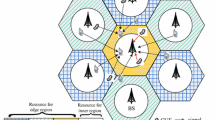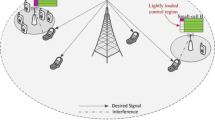Abstract
Heterogeneous networks (HetNets) provide the demand for high data rates. In this study, we analyze the coexistence of femtocells and device-to-device (D2D) communication with macrocells. Interference management and decreasing energy consumption are two important issues in HetNets. To this end, we propose an efficient fractional frequency reuse (FFR)-based spectrum partitioning scheme to reduce the cross-tier interference. We also propose to use different optimization problems for resource allocation in different tiers. For this purpose, an energy efficient optimization problem is applied to D2D user equipment. Further, an optimization problem based on the spectral efficiency, i.e., throughput, is considered for macrocell and femtocell tiers. These problems are modeled as a non-cooperative game that results in low computational complexity. Iterative algorithms with fast convergence are used to solve the optimization problems. It is shown that applying different optimizations on different tiers leads to better performance than considering the same optimization for all tiers. The results indicate that the proposed FFR structure and optimization problems improve system performance. We also analyze the tradeoff between energy efficiency and spectral efficiency of the introduced structure.










Similar content being viewed by others
Abbreviations
- BS:
-
Base station
- CDF:
-
Cumulative distribution function
- D2D:
-
Device-to-device
- D2D Rx:
-
D2D receiver
- D2D Tx:
-
D2D transmitter
- DUE:
-
D2D user equipment
- EE:
-
Energy efficiency
- FBS:
-
Femtocell base station
- FUE:
-
Femtocell user equipment
- FFR:
-
Fractional frequency reuse
- HetNet:
-
Heterogeneous network
- LSN:
-
Log skew normal
- MBS:
-
Macro base station
- MUE:
-
Macrocell user equipment
- PDF:
-
Probability distribution function
- QoS:
-
Quality of service
- RB:
-
Resource block
- RSS:
-
Received signal strength
- SN:
-
Skew normal
- SPPP:
-
Spatial poisson point process
- SE:
-
Spectral efficiency
- UE:
-
User equipment
References
Zahir, T., et al. (2013). Interference management in femtocells. IEEE Communications Surveys & Tutorials,15(1), 293–311.
Chandrasekhar, V., Andrews, J. G., & Gatherer, A. (2008). Femtocell networks: A survey. IEEE Communications Magazine,46(9), 59–67.
Li, Y., et al. (2013). Energy-efficient femtocell networks: Challenges and opportunities. IEEE Wireless Communications,20(6), 99–105.
Asadi, A., Wang, Q., & Mancuso, V. (2014). A survey on device-to-device communication in cellular networks. IEEE Communications Surveys & Tutorials,16, 1801–1819.
Shahid, A., Kim, K. S., De Poorter, E., & Moerman, I. (2017). Self-organized energy-efficient cross-layer optimization for device to device communication in heterogeneous cellular networks. IEEE Access,5, 1117–1128.
Sobhi-Givi, S., Khazali, A., Kalbkhani, H., Shayesteh, M. G., & Solouk, V. (2017). Resource allocation and power control for underlay device-to-device communication in fractional frequency reuse cellular networks. Telecommunication Systems,65, 677–697.
Davaslioglu, K., & Ayanoglu, E. (2014). Quantifying potential energy efficiency gain in green cellular wireless networks. IEEE Communications Surveys & Tutorials,16(4), 2065–2091.
Afroz, F., Sandrasegaran, K., & Al Kim, H. (2015). Interference management in LTE downlink networks. International Journal of Wireless & Mobile, Networks,7(1), 91.
Hsu, C.-C., & Chang, J. M. (2017). Spectrum-energy efficiency optimization for downlink LTE-A for heterogeneous networks. IEEE Transactions on Mobile Computing,16(5), 1449–1461.
Kim, T.-S., Lee, K.-H., Ryu, S., & Cho, C.-H. (2013). Resource allocation and power control scheme for interference avoidance in an LTE-Advanced cellular networks with device-to-device communication. International Journal of Control and Automation,6, 181–190.
Jeon, W. S., Kim, J., & Jeong, D. G. (2014). Downlink radio resource partitioning with fractional frequency reuse in femtocell networks. IEEE Transactions on Vehicular Technology,63, 308–321.
Andrews, J. G., Buzzi, S., Choi, W., Hanly, S. V., Lozano, A., Soong, A. C., et al. (2014). What will 5G be? IEEE Journal on Selected Areas in Communications,32, 1065–1082.
Wang, J., Zhu, D., Zhang, H., Zhao, C., Li, J. C., & Lei, M. (2014). Resource optimization for cellular network assisted multichannel D2D communication. Signal Processing,100, 23–31.
Li, Y., Zhang, L., Tan, X., & Cao, B. (2016). An advanced spectrum allocation algorithm for the across-cell D2D communication in LTE network with higher throughput. China Communications,13(4), 30–37.
Huang, Y., Nasir, A., Durrani, S., & Zhou, X. (2016). Mode selection, resource allocation, and power control for D2D-enabled two-tier cellular network. IEEE Transactions on Communications,64, 3534–3547.
Huo, Liuwei, Jiang, Dingde, & Lv, Zhihan. (2018). Soft frequency reuse-based optimization algorithm for energy efficiency of multi-cell networks. Computers & Electrical Engineering,66, 316–331.
Jiang, D., et al. (2016). An energy-efficient multicast algorithm with maximum network throughput in multi-hop wireless networks. Journal of communications and networks,18(5), 713–724.
Jiang, D., et al. (2015). Network coding-based energy-efficient multicast routing algorithm for multi-hop wireless networks.”. Journal of Systems and Software,104, 152–165.
Jiang, D., et al. (2016). Energy-efficient multi-constraint routing algorithm with load balancing for smart city applications. IEEE Internet of Things Journal,3(6), 1437–1447.
Jiang, D., Li, W., & Lv, H. (2017). An energy-efficient cooperative multicast routing in multi-hop wireless networks for smart medical applications. Neurocomputing,220, 160–169.
Li, Y., et al. (2015). Energy efficiency maximization by jointly optimizing the positions and serving range of relay stations in cellular networks. IEEE Transactions on Vehicular Technology,64(6), 2551–2560.
Li, Y., et al. (2015). Energy-efficient optimal relay selection in cooperative cellular networks based on double auction. IEEE Transactions on Wireless Communications,14(8), 4093–4104.
Hoang, T. D., Le, L. B., & Le-Ngoc, T. (2015). Dual decomposition method for energy-efficient resource allocation in D2D communications underlying cellular networks. In 2015 IEEE global communications conference (GLOBECOM), 2015 (pp. 1–6).
Jiang, D., et al. (2018). A joint multi-criteria utility-based network selection approach for vehicle-to-infrastructure networking. IEEE Transactions on Intelligent Transportation Systems. https://doi.org/10.1109/TITS.2017.2778939.
Zhou, Z., Dong, M., Ota, K., Wu, J., & Sato, T. (2014). Energy efficiency and spectral efficiency tradeoff in device-to-device (D2D) communications. IEEE Wireless Communications Letters,3, 485–488.
Davaslioglu, K., Coskun, C. C., & Ayanoglu, E. (2015). Energy-efficient resource allocation for fractional frequency reuse in heterogeneous networks. IEEE Transactions on Wireless Communications,14, 5484–5497.
Kalbkhani, H., Solouk, V., & Shayesteh, M. G. (2015). Resource allocation in integrated femto-macrocell networks based on location awareness. Communications, IET,9, 917–932.
Alouini, M.-S., & Goldsmith, A. J. (1999). Area spectral efficiency of cellular mobile radio systems. Vehicular Technology, IEEE Transactions on,48, 1047–1066.
Chandrasekhar, V., & Andrews, J. G. (2009). Uplink capacity and interference avoidance for two-tier femtocell networks. Wireless Communications, IEEE Transactions on,8, 3498–3509.
Ben Hcine, M., & Bouallegue, R. (2015). Fitting the Log Skew normal to the sum of independent lognormals distribution. arXiv preprint arXiv:1501.02344.
Dinkelbach, W. (1967). On nonlinear fractional programming. Management Science,13, 492–498.
Zhou, Z., Dong, M., Ota, K., Wu J., & Sato T. (2014). Distributed interference-aware energy-efficient resource allocation for device-to-device communications underlaying cellular networks. In Global communications conference (GLOBECOM), 2014 IEEE (pp. 4454–4459).
Tsiaflakis, P., Necoara, I., Suykens, J. A., & Moonen, M. (2010). Improved dual decomposition based optimization for DSL dynamic spectrum management. IEEE Transactions on Signal Processing,58, 2230–2245.
Boyd, S., Xiao, L., & Mutapcic, A. (2003). Subgradient methods. Lecture notes of EE392o, Stanford University, autumn quarter (Vol. 2004, pp. 2004–2005).
Siswanto,D., Zhang, L., Navaie, K., & Deepak, G. (2016). Weighted sum throughput maximization in heterogeneous OFDMA networks. In 2016 IEEE 83rd vehicular technology conference (VTC Spring) (pp. 1–5).
Yongsheng, C., Yuantao, G., & Xiaokang, L. (2014). Power and channel allocation for device-to-device enabled cellular networks. Computational Information Systems,10, 463–472.
Fodor, G., Della Penda, D., Belleschi, M., Johansson, M., & Abrardo, A. (2013). A comparative study of power control approaches for device-to-device communications. In IEEE international conference on communications (ICC), 2013 (pp. 6008–6013).
Lopez-Perez, D., Guvenc, I., De la Roche, G., Kountouris, M., Quek, T. Q., & Zhang, J. (2011). Enhanced intercell interference coordination challenges in heterogeneous networks. IEEE Wireless Communications,18(3), 22–30.
Lotfollahzadeh, T., Kabiri, S., Kalbkhani, H., & Shayesteh, M. G. (2016). Femtocell base station clustering and logistic smooth transition autoregressive-based predicted signal-to-interference-plus-noise ratio for performance improvement of two-tier macro/femtocell networks. IET Signal Processing,10(1), 1–11.
Chen, D., Jiang, T., & Zhang, Z. (2015). Frequency partitioning methods to mitigate cross-tier interference in two-tier femtocell networks. IEEE Transactions on Vehicular Technology,64(5), 1793–1805.
Author information
Authors and Affiliations
Corresponding author
Appendix
Appendix
Lemma
\(U_{EE,o}^{c}\)is quasi-concave, that is, by increasing the value of\(P_{TD}^{n,c}\), \(U_{EE,o}^{c}\)first increases and then decreases [25].
Proof
We obtain the derivation of \(R_{do}^{n,c} \left( {P_{TD}^{n,c} } \right) = \log_{2} \left( {1 + \gamma_{do}^{n,c} } \right)\) (\(\gamma_{do}^{n,c}\) is given in (12)) with respect to \(P_{TD}^{n,c}\) as follows
where
It is apparent that \(\frac{{\partial R_{do}^{n,c} \left( {P_{TD}^{n,c} } \right)}}{{\partial P_{TD}^{n,c} }} > 0\). Thus \(R_{do}^{n,c} \left( {P_{TD}^{n,c} } \right)\) increases by increment of \(P_{TD}^{n,c}\).
Also taking the derivation of \(U_{EE,o}^{c} = \frac{{\sum\nolimits_{l = 1}^{{N_{D} }} {R_{do}^{l,c} \left( {P_{TD}^{l,c} } \right)} }}{{\sum\nolimits_{l = 1}^{{N_{D} }} {P_{T,do}^{l,c} } + 2P_{cir} }}\) (eq. (22)) with respect to \(P_{TD}^{\,n,c}\) yields
where \(b = \sum\nolimits_{l = 1}^{{N_{D} }} {P_{\,T,do}^{\,l,c} } + 2P_{cir}\). The positive value of denominator can be ignored so the shortened equation is defined as:
In this way, \(N(\infty ) = \mathop {\lim }\limits_{{P_{TD}^{n,c} \to \infty }} \,N(P_{TD}^{n,c} ) = \frac{1}{\ln \left( 2 \right)} - \infty < 0\) and \(N(0) = \mathop {\lim }\limits_{{P_{TD}^{n,c} \to 0}} \, N(P_{TD}^{\,n,c} ) = \frac{{2K_{d}^{\,n,c} P_{cir} }}{\ln \left( 2 \right)a} > 0\)
Taking the first-order derivation of \(N(P_{TD}^{n,c} )\) results in
Therefore, it is concluded that \(N\left( \infty \right) < N(P_{TD}^{n,c} ) < N\left( 0 \right).\) Consequently, when \(P_{\,TD}^{\,n,c} < P_{\,TD,o}^{\, * ,c}\), we have \(\frac{{\partial U_{EE,o}^{\,c} }}{{\partial P_{\,TD}^{\,n,c} }} > 0\) and \(\frac{{\partial U_{EE,o}^{\,c} }}{{\partial P_{\,TD}^{\,n,c} }} < 0\) when \(P_{\,TD}^{\,n,c} > P_{\,TD,o}^{\, * ,c}\). Hence, the increment and then decrement of \(U_{EE,o}^{\,c}\) by increasing the value of \(P_{\,TD}^{\,n,c}\) is proved. As a result, the concaveness of numerator and denominator of \(U_{EE,o}^{\,c}\) results in the quasi concaveness of \(U_{EE,o}^{\,c}\). Similar results hold for \(U_{EE,\,i}^{\,k} .\)
Rights and permissions
About this article
Cite this article
Khazali, A., Sobhi-Givi, S., Kalbkhani, H. et al. Energy-spectral efficient resource allocation and power control in heterogeneous networks with D2D communication. Wireless Netw 26, 253–267 (2020). https://doi.org/10.1007/s11276-018-1811-3
Published:
Issue Date:
DOI: https://doi.org/10.1007/s11276-018-1811-3




